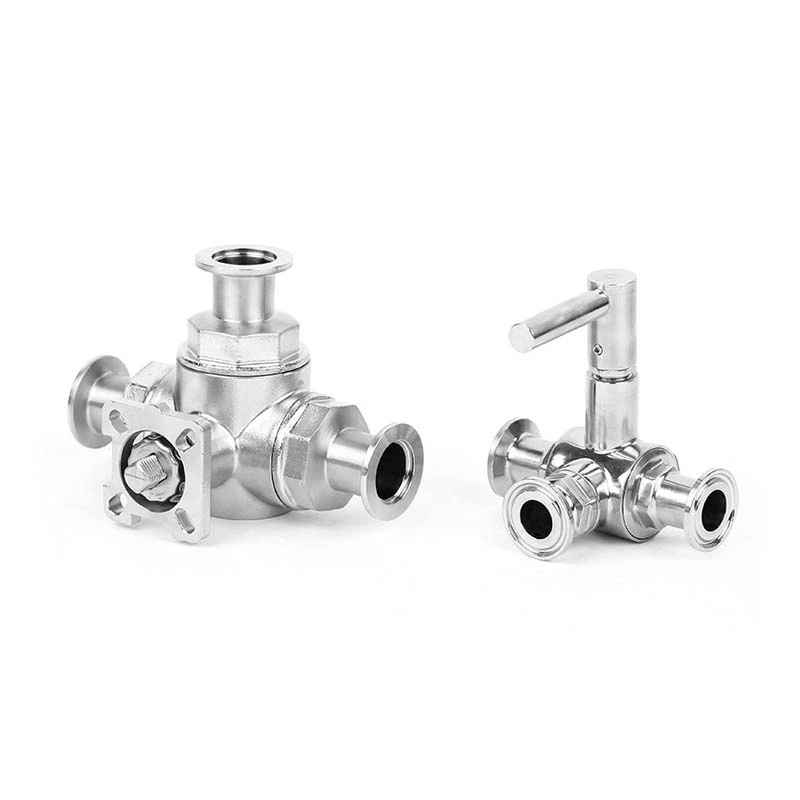The Structure Of Sanitary Ball Valve
Sanitary Ball Valve is a fluid control device designed for industries with high hygiene requirements such as food, pharmaceuticals, and chemicals. Its structure mainly includes valve body, ball, valve seat, valve stem, sealing packing, actuator, connection method and auxiliary parts.
2 tri clamp ball valve structure
1. Valve body
The valve body is the main component of the tri clover ball valve, usually made of stainless steel to meet the requirements of hygiene and corrosion resistance. The internal structure of the valve body is reasonably designed to ensure that the fluid will not be obstructed when flowing inside the valve, and it is convenient for cleaning and disinfection.
2. Ball
The ball is a key component of the 1 2 tri clamp ball valve and is responsible for controlling the on and off of the fluid. The ball is usually made of stainless steel or special alloy, and the surface is polished to ensure that the fluid will not be contaminated when flowing on the surface of the ball. There is a channel inside the ball. When the ball rotates to a position that fits the valve seat, the channel is closed to prevent the fluid from passing; when the ball rotates to a position separated from the valve seat, the channel opens to allow the fluid to pass.
3. Valve seat
The valve seat is the sealing component of the ball valve clamp, which fits tightly with the ball to prevent fluid leakage. The valve seat is usually made of elastic materials such as PTFE (polytetrafluoroethylene) or EPDM (ethylene propylene diene monomer rubber), which has good sealing performance and corrosion resistance.
4. Valve stem
The valve stem is used to connect the actuator and the ball, and is responsible for driving the ball to rotate to achieve on-off control of the fluid. The valve stem is usually made of stainless steel and the surface is polished to prevent fluid from remaining on the surface of the valve stem. There is a channel inside the valve stem to allow the sealing packing to pass through to achieve the sealing of the valve stem.
5. Sealing packing
The sealing packing is used to fill the gap between the valve stem and the valve body to prevent fluid from leaking from the gap. The sealing packing is usually made of materials such as polytetrafluoroethylene (PTFE) or graphite, which has good sealing performance and corrosion resistance.
6. Actuator
The actuator is the power source of the clamp ball valve, responsible for driving the valve stem and the ball to rotate. The actuator can be manual, pneumatic, electric or hydraulic, and can be selected according to specific needs. The selection of the actuator should meet the requirements of the switching speed, torque and reliability of the clamp on valve.
7. Connection method
The connection method of the full bore sanitary ball valve is usually clamp type, quick-install type or flange type. The clamp type connection is convenient and fast, suitable for small-diameter valves; the quick-install type connection is suitable for occasions that require frequent disassembly; the flange type connection is suitable for large-diameter valves and high-pressure environments, seamless welding type. The choice of connection method should be selected according to the specific use environment and requirements.
8. Auxiliary components
The auxiliary components of the hygienic stainless steel valves include discharge ports, cleaning ports and observation windows. The discharge port is used to discharge the accumulated liquid or gas inside the valve; the cleaning port is used to clean the inside of the valve; the observation window is used to observe the working conditions inside the valve. The setting of auxiliary components should be convenient for use and maintenance, and meet the hygiene requirements.
The structure of the pneumatic sanitary ball valve covers multiple aspects such as the valve body, ball, valve seat, valve stem, sealing packing, actuator, connection method and auxiliary components. The selection and design of these components should meet the special requirements of sanitary ball in the food, pharmaceutical, chemical and other industries to ensure the purity and sterility of the fluid.
